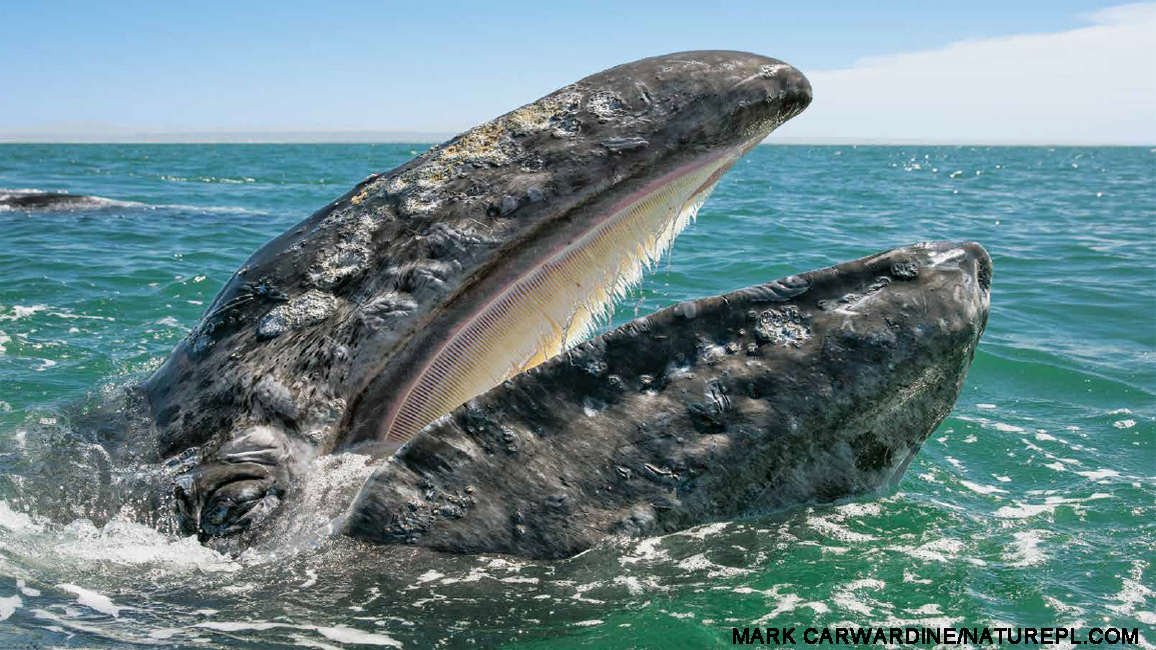
Who Needs Teeth?
By Kathy KrankingNot the animals in this story! It’s hard to imagine what life would be like if you didn’t have teeth. But the ocean animals you’ll meet here get along just fine even though they don’t have any. For them, chowing down without chewing up is no problem at all!

MOUTH TRAP
Instead of having teeth, a gray whale has stiff bristles of baleen (buh-LEEN) in its mouth. Baleen is great for trapping the whale’s favorite foods: worms, shrimp, and other tiny creatures that live along the ocean floor. To eat them, the whale rolls on its side and swims near the seabed, sucking in water, mud, and the little creatures hiding in the mud. The creatures get caught on the bristly baleen, while the mud and water flow back out of the whale’s mouth. Then—gulp!—the whale swallows its meal.

Supper Sucker-Upper
See the long snout on this lined seahorse? The seahorse uses it as a built-in straw to suck in its food. It swims along, slurping up tiny shrimp, plankton, and worms it finds. Then it swallows them whole.
Full-Body Feaster
A vase sponge may not look like an animal, but it is one. And it doesn’t just eat without teeth. It eats without even having a mouth! Instead, it has tiny openings, called pores, all over its body. The sponge pumps water in through the pores, collecting tiny plants and animals called plankton, as well as other bits of food to eat. Then it pumps the water, and any wastes, back out through the opening on top.
Crunch Time
An eagle ray likes to eat mostly crunchy meals such as crabs, clams, and mussels. Using its snout, it noses through the sand on the ocean floor, looking for prey. When it comes across something to eat, it sucks it in and then crushes the animal’s shell with hard, flat plates inside its mouth. Finally, the ray swallows the soft animal inside.
Big, Bad Beak
This hungry squid has caught a fish for dinner. It uses its tentacles to move the fish toward its mouth. Where’s the mouth? In the center of the squid’s arms. And inside its mouth is a hard, sharp beak (circle) that looks like a bird’s beak. The squid uses the beak to tear its meal into pieces.

Scratchy Throat
The leatherback sea turtle often feeds on soft, slippery creatures such as jellyfish. It uses its sharp beak to grab them, but it doesn’t have teeth for chewing them up. Instead, it has something even better. Its throat is lined with backward-pointing spines. Once the turtle slurps a meal in, the spines keep it from coming back out!
Sharp Tongue
If you saw this flamingo tongue snail moving along a fan coral, you might not even know it was eating the coral. But it is using its sharp, file-like tongue to scrape away at its food.
Stunning “Nose”
Even though a swordfish’s bill looks like a nose, it’s really a super-long upper jaw. A hungry swordfish uses the bill to get food. It dashes into a group of fish, slashing back and forth with the bill. This kills or stuns some of the fish, and then the swordfish gobbles them up.
Eating Out
A sea star has a really different way of eating. It slowly crawls over its prey and covers it with its body. Then it pushes its stomach outside its
body and surrounds the prey with it. Slowly, the stomach’s digestive juices turn the prey into a soup-like “chowder,” which the sea star takes into its body.
Whether they eat by slurping, sucking, slashing, or other ways, for some animals, it’s “No teeth? No problem!”
















